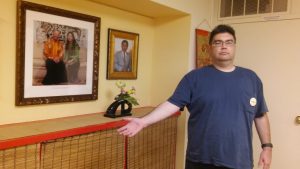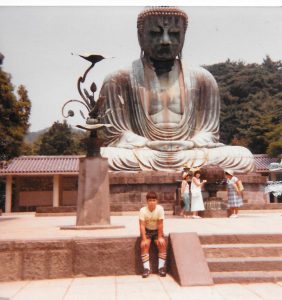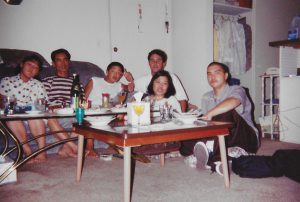Sunday
Featured StoriesAmerica and Me/Shambhala and Me, Pt. 2
Part two of a three part series describing one Shambhalian’s experience growing up as part of an interracial family
by David Ken Engelbrecht
 In October 2009, I left Los Angeles and moved to Vancouver, Washington. I did not go outside alone for twenty months. If I did go out, I stayed in my parent’s car, and sometimes I would listen to Pema Chodron audio recordings while I waited. When I was around twenty years old my parents re-married, and they have been my primary support outside the public mental health system. They still didn’t understand my mental health challenges. I was in a physical cocoon. I was afraid of everyone and everything. I would spend my time online looking at dharma centers in Portland, Oregon. I would see Pema’s picture on Shambhala websites, so I felt an initial connection with them because I had already connected with her teachings. As I read through their website, I came across Shambhala’s diversity policy. All those years I had felt like an outcast. The only thing I really wanted was to belong to a group or to a community. Shambhala looked like a place I might fit in. Around 2010, I was riding home in my parent’s car, and I asked them to drive by the center. As we drove by, I felt a powerful force that was telling me to find a way to connect with Shambhala.
In October 2009, I left Los Angeles and moved to Vancouver, Washington. I did not go outside alone for twenty months. If I did go out, I stayed in my parent’s car, and sometimes I would listen to Pema Chodron audio recordings while I waited. When I was around twenty years old my parents re-married, and they have been my primary support outside the public mental health system. They still didn’t understand my mental health challenges. I was in a physical cocoon. I was afraid of everyone and everything. I would spend my time online looking at dharma centers in Portland, Oregon. I would see Pema’s picture on Shambhala websites, so I felt an initial connection with them because I had already connected with her teachings. As I read through their website, I came across Shambhala’s diversity policy. All those years I had felt like an outcast. The only thing I really wanted was to belong to a group or to a community. Shambhala looked like a place I might fit in. Around 2010, I was riding home in my parent’s car, and I asked them to drive by the center. As we drove by, I felt a powerful force that was telling me to find a way to connect with Shambhala.
June 25, 2011, was the day I finally contacted Portland Shambhala. I was in great distress. My life was going nowhere. I felt trapped and hopeless. That day would be the beginning of my way out of the physical cocoon. I sent an email to the center and said I wanted to get involved, but I had panic attacks and phobias. In a couple days, I got a reply. The office manager asked me if I wanted to talk to a meditation instructor (MI). I did not know what that was, but talking to another human being sounded good. I said “yes.” My message was forwarded to the MI coordinator and soon I was told someone would meet with me, but I had to contact him first. I did. It turned out he had a daughter with similar mental health challenges. We met in July 2011.
 My first 10 months in Shambhala were awkward for me. I did not have a college degree (I dropped out of junior high). I was below the poverty line (I’m on Social Security Income). I was half white/half Japanese. I didn’t have a job or career. I lived with my parents. I had been homeless and stuck in the public mental health system in Los Angeles for many years. I wasn’t sure where I fit in. When I was taking Meditation in Everyday Life (MIEL) in December 2011, my mother found this picture of me. It was taken before I started the 5th grade. When I saw the photo, I thought it was like Buddha was telling me not to forget my true nature.
My first 10 months in Shambhala were awkward for me. I did not have a college degree (I dropped out of junior high). I was below the poverty line (I’m on Social Security Income). I was half white/half Japanese. I didn’t have a job or career. I lived with my parents. I had been homeless and stuck in the public mental health system in Los Angeles for many years. I wasn’t sure where I fit in. When I was taking Meditation in Everyday Life (MIEL) in December 2011, my mother found this picture of me. It was taken before I started the 5th grade. When I saw the photo, I thought it was like Buddha was telling me not to forget my true nature.
Over the next couple of decades after that picture was taken, my true nature would be covered over by layer after layer of confusion and bewilderment. I was connecting with Shambhala, but I was about to go through another layer and didn’t know it yet. I hadn’t been on my psychiatric medication for over 30 months, and my thinking was becoming more and more distorted. I thought things were happening that were not. I was becoming paranoid and thought people were afraid of me. I disappeared for a couple months. I had a psychotic break. I thought people wanted to file a restraining order against me because they thought I was dangerous, because I was different from them. I was able to get back on medication, and after a period of reality checks, I was able to realize that what I had thought was not true.
I now have friends at Portland Shambhala. When I walk into the center, people know my name. People actually care about me. I was in the psychiatric hospital back in October 2014 and my MI visited me. She brought a copy of Turning the Mind into an Ally for me to read. How ironic. If there was any place in the world I would want to turn my mind into an ally, it would be in a psychiatric hospital. At Portland Shambhala, I feel I belong. I am no longer the angry outcast. Whatever that force was that was calling me to connect with Shambhala, it had the wisdom to know what I needed.
I am not the first one with mental health challenges to seek support from Shambhala. There are others. There were also people before Shambhala Meditation Centers were established. In The Sanity We Are Born With, Chogyam Trungpa talks about it:
Sometimes it is very hard to communicate to Westerners the importance of the experiential dimension. After we had started Samye Ling, our meditation center in Scotland, soon after I came from India to England, we found that a great many people with psychological problems came to us for help. They had been in all sorts of different therapies, and many of them were quite neurotic. They looked on us as physicians carrying out medical practice and wanted us to cure them. In working with these people I found that there was a frequent obstacle. Such people often wanted to take a purely theoretical approach, rather than actually experiencing and working with their neuroses. They wanted to understand their neuroses intellectually: where they themselves went wrong, how their neuroses developed, and so on. They often were not willing to let go of that approach.
 Basic Goodness 1(BG1) is entitled “Who Am I?” In a worldly way, I was always asking this question: Who am I? It felt like people were asking me a different question: “What are you?” In The Shambhala Principle, Sakyong Mipham writes about his father Chogyam Trungpa: “He told me that people would not ask ‘Who are you?’ but ‘What are you?’ He would reply, ‘I am a human being.’” I could really relate to that. If you removed all the labels I have been given over my four decades of life: Fat Jap, Lard, Mentally Ill Monster, Wino, Crackhead, Homeless Bum, etc., I would be a human being. I seem to want an identity I can cling to (This is “me.” I am real. I exist.). I Am This. But who is this “I”? What is there if this “I” is removed? Will I just be what is? Will there be basic sanity, or basic anxiety? I don’t know the answer to these open-ended existential questions. I do know in that this world, if I look a certain way I could get hurt or be killed. I could be treated badly or as less than a human being.
Basic Goodness 1(BG1) is entitled “Who Am I?” In a worldly way, I was always asking this question: Who am I? It felt like people were asking me a different question: “What are you?” In The Shambhala Principle, Sakyong Mipham writes about his father Chogyam Trungpa: “He told me that people would not ask ‘Who are you?’ but ‘What are you?’ He would reply, ‘I am a human being.’” I could really relate to that. If you removed all the labels I have been given over my four decades of life: Fat Jap, Lard, Mentally Ill Monster, Wino, Crackhead, Homeless Bum, etc., I would be a human being. I seem to want an identity I can cling to (This is “me.” I am real. I exist.). I Am This. But who is this “I”? What is there if this “I” is removed? Will I just be what is? Will there be basic sanity, or basic anxiety? I don’t know the answer to these open-ended existential questions. I do know in that this world, if I look a certain way I could get hurt or be killed. I could be treated badly or as less than a human being.





Oct 14, 2016
Reply
ahh! This story reminds me of me and first going to the Shambhala Ctr. and never doubting the value and
goodness of the teachings. Thank You
Oct 14, 2016
Reply
Thank you, David. And thank you, Shambhala. This is a beautiful story, told with simple clarity, and heart.